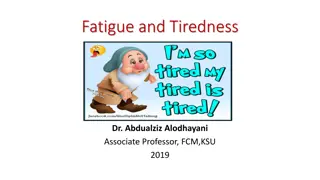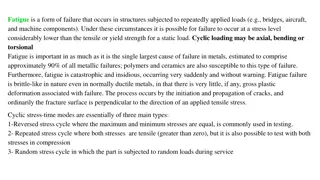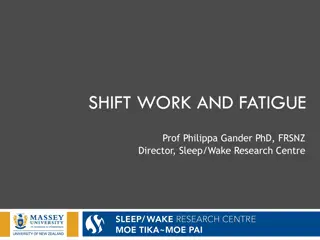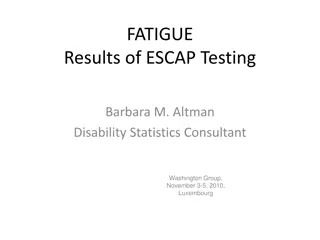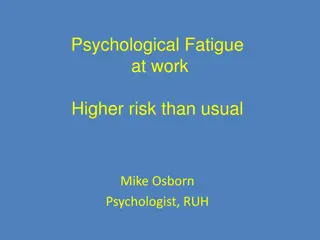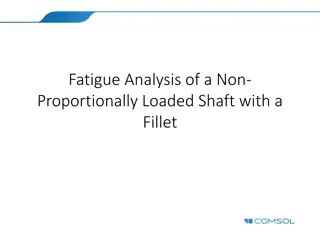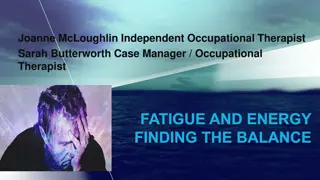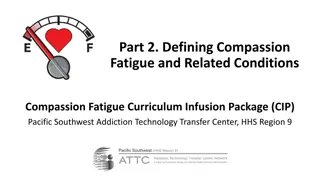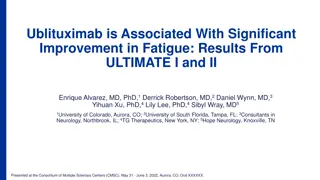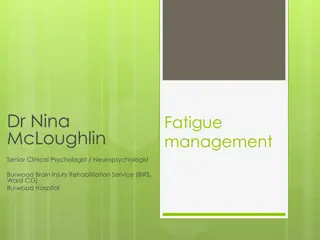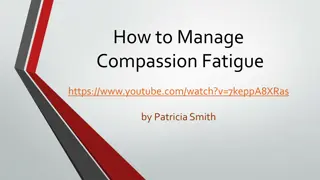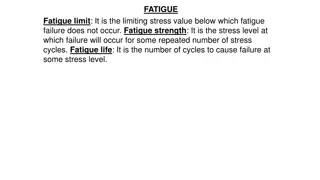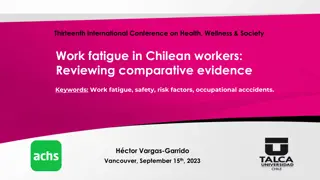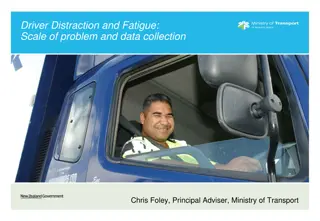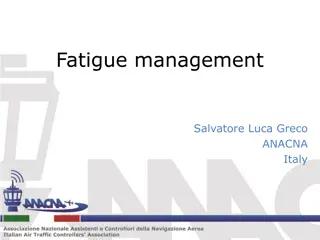Understanding and Managing Fatigue: Insights and Risks
Fatigue is a state of exhaustion, both physically and mentally, that can lead to decreased alertness and increased crash risks. Factors contributing to fatigue include inadequate sleep, reliance on external stimuli for wakefulness, and the nature of driving during risk periods. Recognizing signs of fatigue such as nodding off, blurred vision, and mood changes is crucial to prevent and manage fatigue-related incidents. Sleep apnea, a common risk factor, obstructs the airway during sleep and affects individuals with specific characteristics.
Uploaded on Sep 14, 2024 | 0 Views
Download Presentation

Please find below an Image/Link to download the presentation.
The content on the website is provided AS IS for your information and personal use only. It may not be sold, licensed, or shared on other websites without obtaining consent from the author. Download presentation by click this link. If you encounter any issues during the download, it is possible that the publisher has removed the file from their server.
E N D
Presentation Transcript
Managing Fatigue Jill Manaia, South Taranaki District Council October 2023
What is fatigue A state of physical and mental exhaustion that results in the loss of alertness
Fatigue related crashes Rates of fatigue related crashes trending down since peak 2013 (death and serious injury only) 3% of fatal truck crashes and 8% fatal car crashes related to fatigue probably under reported Percentage varies over time of day Head on or lost control type accidents Overtaking/lane changes
The size of the problem In 2021 there were... 21 fatal crashes 69 serious injury crashes 422 minor injury crashes where fatigue was a contributing factor Likely to be underreported 25 killed, 92 serious injuries, 533 minor injuries
A fatigued driver Will have driven some time without a break May be reliant on external factors to keep awake May have had disturbed/inadequate sleep the night(s) before May suffer from a sleep related condition May be a shift worker or commercial driver May be driving during risk periods May be unaware of fatigue related symptoms
Signs of fatigue Nodding off Difficulty keeping eyes open/blurred vision Feeling "spacey" or "fuzzy" Clumsiness Slowed reflexes Tailgating / poor speed control/drifting Tunnel vision on task Poor risk assessment /judgement Increased errors Reduced memory Grumpiness and moodiness / road rage Microsleeps
Sleep Apnoea Risk Factors Obstruction of airway during sleep Male Over 40 Medical conditions Short thick neck Lifestyle alcohol, smoking Obesity Family history
Laws around fatigue Commercial related driving Health and Safety at Work Act 2015 Section 30 Management of risks Section 36 Primary duty of Care Manage risks Provide a safe environment Provide safe systems of work Section 45 - Duties of workers
Managing the Risk of Fatigue Fatigue Education and training Roster management and design Driving assessments Management Plan Medical surveillance Medical conditions, sleep apnoea Hours of work management. Travel Policy Support sleep studies In cab monitoring Driver Management of alerts management Breaks and nutrition In cab alerting
NZ Case Law Fatigue related Worksafe NZ v Michael Vining Contracting Ltd [2018] Freight Lines Ltd (2015) Maritime : Wild Fish NZ (2018) Waka Kotahi - numerous
Resources WorkSafe Fatigue guidance Driver fatigue | Waka Kotahi NZ Transport Agency Fatigue Management Advice for employers | Waka Kotahi Health and safety, fatigue - Maritime NZ Fighting Driver Fatigue | NZI Effects Of Fatigue And Minimizing Strategies #SDT



